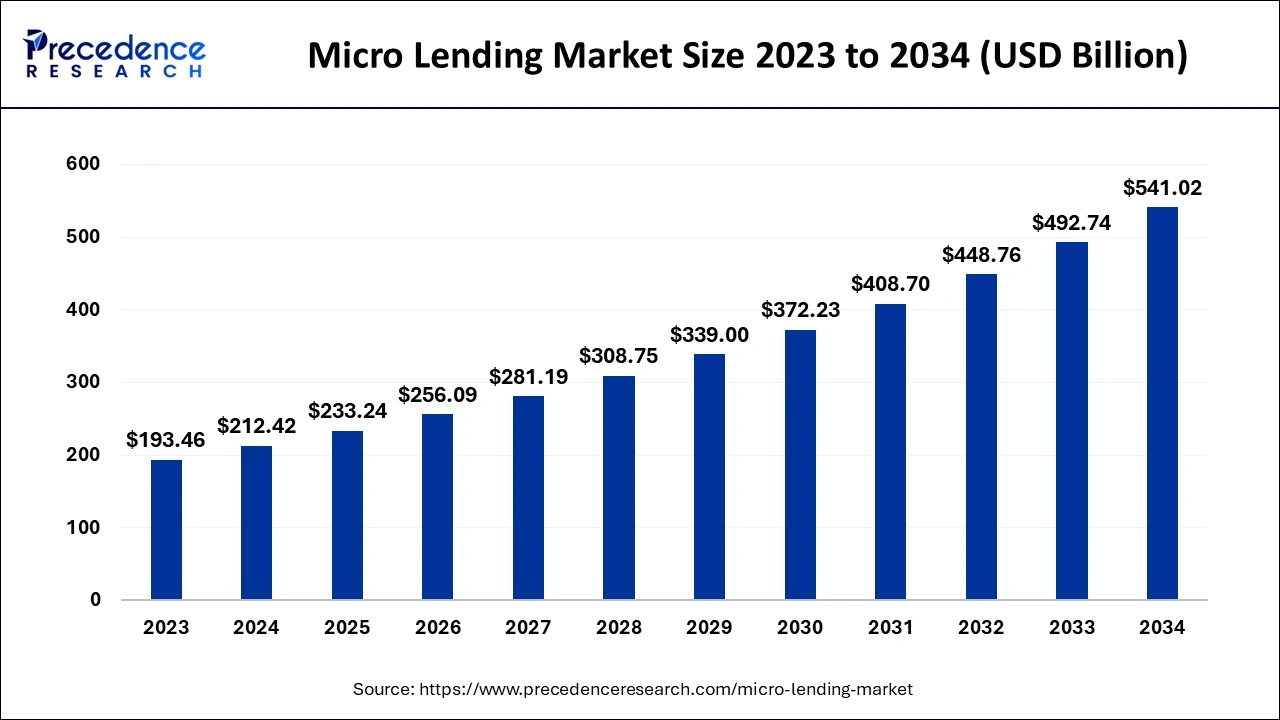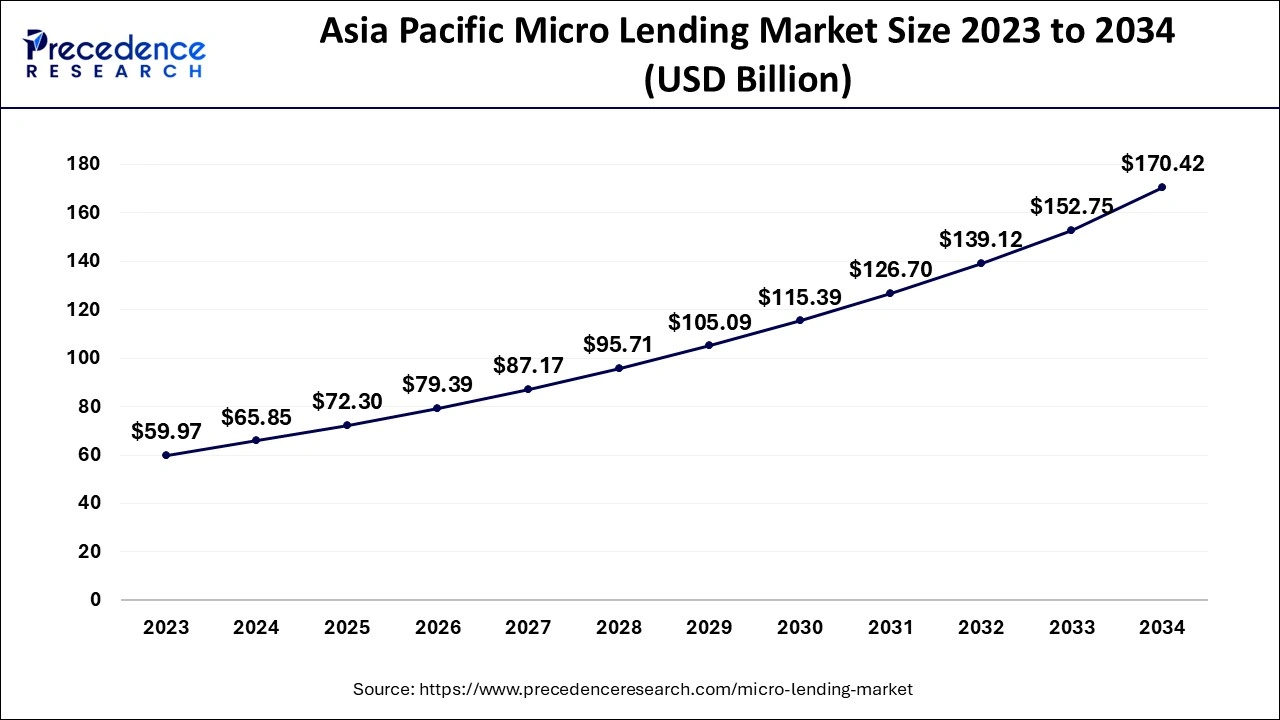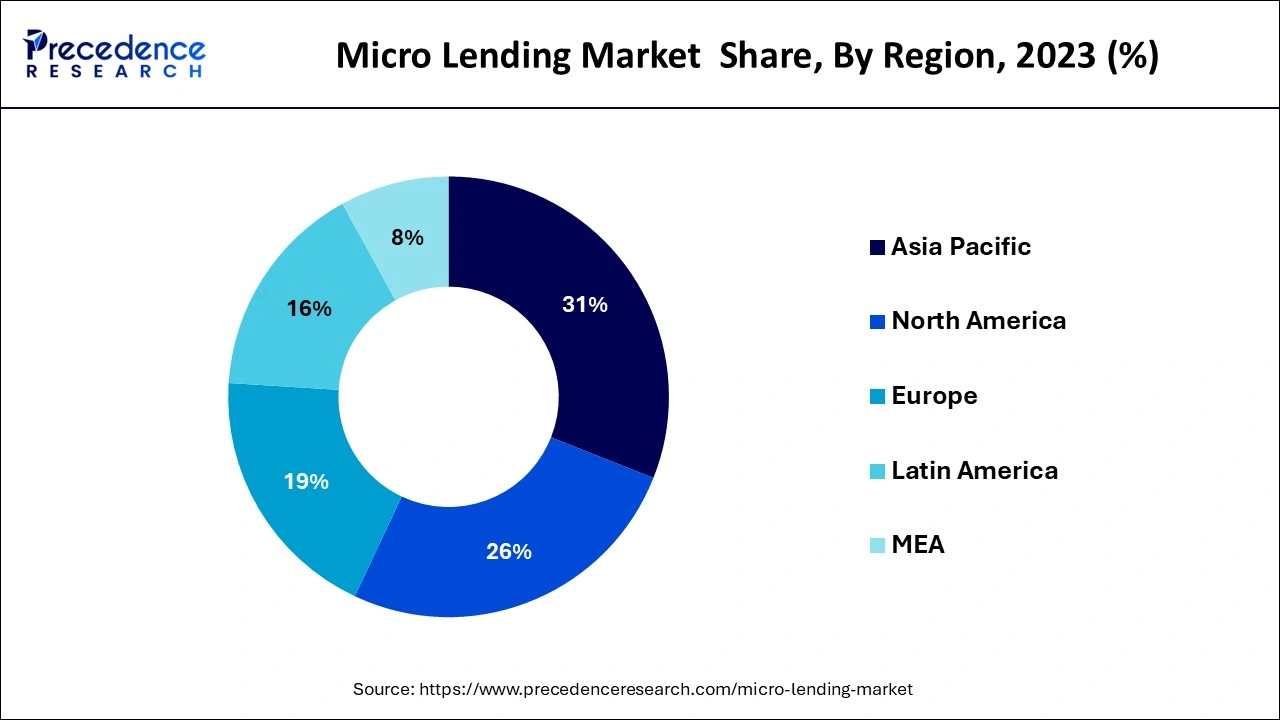Micro Lending Market Size and Forecast 2025 to 2034
The global micro lending market size accounted at USD 212.42 billion in 2024 and is anticipated to reach around USD 541.02 billion by 2034, expanding at a CAGR of 9.80% between 2025 and 2034.

Micro Lending Market Key Takeaways
- In terms of revenue, the micro lending market is valued at $233.24 billion in 2025.
- It is projected to reach $541.02 billion by 2034.
- The micro lending market is expected to grow at a CAGR of 9.80% from 2025 to 2034.
- By provider, the banks' segment has contributed a market revenue share of over 56% in 2024.
- By End-user, the micro, small, and solo segments contributed a market revenue share of around 69% in 2024.
- The Asia Pacific region has held the highest revenue share of around 31% in 2024.
Asia Pacific Micro Lending Market Size and Growth 2025 to 2034
The Asia Pacific micro lending market size accounted at USD 65.85 billion in 2024 and is predited to be worth around USD 170.42 billion by 2034, growing at a CAGR of 9.98% between 2025 and 2034.

The worldwide microlending market has been divided into five regions based on geography: North America, Europe, Asia Pacific, Latin America, and the Middle East & Africa. The Asia Pacific market currently has the largest revenue share in the overall microlending market, and this trend is anticipated to last over the course of the forecast period, with China and India's markets expected to contribute significantly more revenue than those of the other countries in the region. Favorable government policies for microlending facilities, particularly those for people in rural regions in the region's countries, can be credited with the market growth in the Asia Pacific. Over the course of the forecast period, the North American market is anticipated to provide the second-largest revenue share to the worldwide microlending market.
What Is Fueling the Substantial Growth of the North American Micro Lending Market?
The North American micro lending market is expected to witness significant growth over the forecast period. The area has a well-developed system of financial organizations as well as a rapidly growing sphere of fintech, which provides a variety of micro-lending services to individual users or small corporations. This market is being stimulated by expanding awareness of alternative financing solutions and expanding demand for flexible credits. Besides, having favourable regulatory systems, government efforts at encouraging entrepreneurial processes, and the development of small businesses present a favourable condition that will facilitate the success of micro lending.

What Factors Are Driving the Significant Growth of the Latin American Micro Lending Market?
Latin America is expected to expand at a significant CAGR in the forecast period. It is spurred mostly by the rise in the number of micro lending platform providers in the region. These platforms are increasing access to financial services, particularly to the underserved, including small business owners, people with low income, and people living in rural areas. Lending of microloans has been enabled more by the advancement of digital financial technologies and mobile banking, which have eliminated the complexity of obtaining a loan, as well as the process of disbursing the loan.
Moreover, the governments and the regulatory authorities are implementing initiatives to increase financial inclusion, develop small businesses, which, as a result, contribute to the demand for microloans. The market is experiencing strong growth as the awareness about micro lending rises and the use of technology comes into use, thus enabling the market to bridge the gap in credit and entrepreneurship development in the Latin American market.
Market Overview
Small company owners and individuals can get funds through microlending to assist in managing their financial operations. Additionally, microlending is crucial for many developing nations since it gives the financially underserved, such as those who are unable to obtain checking accounts, lines of credit, or loans from conventional banks, access to cash. Additionally, governments in a number of developing nations are establishing favorable microloan policies to boost their economies.
The worldwide micro lending market is growing significantly due to the increased acceptance of micro lending in emerging countries for better lifestyles and lower operating and market risk. Additionally, the increased ability of entrepreneurs to establish new enterprises and do so with less financing assistance has a favorable influence on the expansion of the micro lending market. However, it is anticipated that the tiny loan amounts and short payback terms offered by microlenders would restrain market expansion. On the other hand, it is anticipated that the market would benefit financially from the implementation of advanced technologies in microfinance.
The idea of individual money lending with the aim of supporting small company expansion or providing finance for personal necessities is known as micro lending or micro-financing. People in developing nations benefit particularly from micro lending since it gives them access to a variety of job opportunities. Additionally, micro lending programs help low-income families leave the group of people who are poorer than average.
Microloans are currently being substantially digitized to attract new lenders to the market. Borrowers are frequently required to choose a loan purpose and loan amount on private microlending platforms. The lending platform will evaluate the borrower's creditworthiness and set the loan's conditions after receiving the complete application. Before financing the loan, some microloan platforms would look for investments from a range of private investors.
The continuing COVID-19 epidemic has had a serious impact on the economies of several nations as well as the global populace. Lending is now necessary because of the losses suffered by several small enterprises. As a result, there would soon be a chance for the worldwide microlending sector to expand.
Micro Lending Market Growth Factors
Over the projected period, the worldwide microlending market is anticipated to expand significantly. The initiatives being pursued by different governments, especially those of emerging economies, to ensure access to capital for the financially underserved, such as those who are unable to obtain lines of credit, checking accounts, or loans from conventional banks; and the policies being drafted by these governments to encourage microlending as part of the economic development are expected to drive the growth of the market over the forecast period.
The industry is expanding as a result of technological developments, ongoing digitization, the widespread use of mobile phones, the popularity of e-wallets, and mobile credit. The ease and hassle-free repayment of loans are made possible in particular by digital technology, which lowers costs and increases efficiency while decreasing cash-related hazards.
Market Scope
| Report Coverage | Details |
| Market Size in 2024 | USD 212.42 Billion |
| Market Size in 2025 | USD 233.24 Billion |
| Market Size by 2034 | USD 541.02 Billion |
| Growth Rate from 2025 to 2034 | CAGR of 9.80% |
| Largest Market | Asia Pacific |
| second-largest Market | North America |
| Base Year | 2024 |
| Forecast Period | 2025 to 2034 |
| Segments Covered | Provider, End User, and Region |
| Regions Covered |
North America, Europe, Asia-Pacific, Latin America and Middle East & Africa |
MarketDynamics
Drivers
- The adoption of advanced technology - One of the major factors fostering the expansion of the microlending business is the use of cutting-edge technology in microfinance. With the freedom to repay loans via mobile phones and avoiding the hazards of cash-in-transit, several major companies are introducing new technologies to expand their market share and give clients a better experience. Additionally, employing digital technology makes it possible to repay loans promptly, reducing the risks associated with handling cash. This is driving a rise in digitization throughout the global microlending market and is anticipated to support market expansion over the course of the projected period.
- Peer-to-peer financing - Peer-to-peer commerce has completely changed how individuals do business, and P2P apps have enabled some remarkable developments in the financial industry. Microloans are currently tiny loans that are offered by individuals rather than banks or credit unions thanks to peer-to-peer lending. These loans may be made by a single person or by a group of people who each contribute a share of the overall sum.
Key Market Challenges
- Lack of awareness about financial services - One of the major challenges impeding the expansion of the microlending business is the lack of knowledge about financial services. Low-income groups benefit greatly from MFIs. However, they encounter significant difficulties as a result of the public's ignorance of financial services. The majority of MFI clients lack sufficient understanding of how microlending operates, and many of them don't even comprehend the loan procedure. As a consequence, lack of knowledge is increasingly posing problems for microlending operations, which will have a detrimental effect on the expansion of the global microlending market throughout the forecast period.
Key Market Opportunities
The growing use of microlending in developing countries drives market demand
- Many people's lives in developing Asia-Pacific and LAMEA nations are being transformed through microlending or microfinance by giving them financial help. The sector is growing as a result of expanded government microloan initiatives in several countries. Additionally, a rise in microlenders helps many developing countries eradicate poverty and improve the standard of living for the poor. For instance, Bangladeshi research showed that microfinance was to blame for a 40% drop in poverty nationwide.
- Additionally, microloans are often used by African farmers to buy crops, which stimulates market growth. Additionally, rural folks borrow money from microlenders to launch their businesses and upgrade their standard of living.
Growth opportunities due to online banking
- Online banking has grown significantly in recent years as a result of the widespread usage of cell phones and the internet. Microlending is a practical and well-liked option for lenders since it provides borrowers with rapid affordability. Many businesses and individuals have started applying for loans online in recent years instead of going through drawn-out lending processes.
- The Federal Reserve estimates that around 49% of small businesses globally requested loans from banks and non-banking organizations. The sector is growing as a result of how easy it is for borrowers to apply for loans and all the benefits that lenders get, such as automated loan administration and speedy approval.
Provider Insights
During the anticipated term, the bank's segment's market share of microlending will expand significantly. Due to the major advantages that microlending institutions provide to low-income groups, demand for microlending is anticipated to rise throughout the projected period. Additionally, the necessity to offer simple credit and give consumers modest loans without any security boosts people's choice for microlending institutions, which in turn spurs the expansion of the target market. The same trend is anticipated in the upcoming years.
There is a clear market trend at the global level. The rise of microlenders aids several emerging nations in eliminating poverty and raising the standard of living for the underprivileged. Due to the region's significant expenditures and development of manufacturing facilities, the consumer finance industry in North America has been growing at a steady rate and is anticipated to continue growing during the projected period.
Government's initiatives to aid banks in microlending help the sector. In order to follow trends in the microfinance industry, such as disbursements delinquencies, state-wise distribution, top loan types, etc., Small Industries Development Bank of India (SIDBI) and Equifax launched a first-of-its-kind weekly called "Microfinance Pulse." This information will serve as a lighthouse to guide the microfinance sector and regulators through the peaks and valleys of the loan cycle, eventually facilitating responsible lending.
Microfinance for housing is expanding quite quickly. Around the world, there are more organizations offering housing microfinance. About 200 microfinance organizations throughout the world are currently financially sustainable. Microfinance for housing is more widespread in Latin America and growing in Asia and Africa. Additionally, the entire portfolios of microfinance organizations only include a minor portion of housing microfinance. Opportunities for expansion that microfinance institutions had in some areas, such as Bolivia and Bangladesh, have been restricted by rising competition.
End-users Insights
The newest magic bullet for eradicating poverty is microcredit. Rich benefactors are committing hundreds of millions of dollars to the microcredit movement, including billionaire George Soros and Pierre Omidyar, co-founder of eBay. Global commercial banks are launching microfinance funds, including Citigroup Inc. and Deutsche Bank AG. Even those with only a few dollars to spare can lend money to Togolian auto mechanics and Ecuadorian rice farmers by visiting microcredit Web sites and clicking their mouse.
Untold billions of dollars have been attracted by all this enthusiasm for microcredit. Over the past ten years, just one microloan provider, Grameen Bank, has issued $4 billion to its 7 million Bangladeshi customers. According to Sanjay Sinha, managing director of Micro-Credit Ratings International in India, 300 commercial banks and roughly 1,000 microcredit groups in India financed $1.3 billion to 17.5 million individuals in the previous year. The State of the Microcredit Summit Campaign Report reveals that 3,133 microcredit institutions worldwide loaned money to 113.3 million customers.
Targeting women is a further innovation that many nonprofit microfinance firms have implemented. Women make up 97 percent of the clientele at Grameen Bank, for instance, since they "have longer vision and desire to transform their lives much more intensely," according to Yunus. Men are, nevertheless, "more ruthless with money,"
There is evidence to support the idea that women who control their microloans spend more on their families welfare, security, and health.
Companies Positive Info
- Accion International : Accion International demonstrates the positive impact of microfinance in a wide variety of emerging nations. Such an approach shields people from short-term and long-term economic problems. Because of its social mission, Accion is a main driver of change and entrepreneurship for underprivileged communities across the globe.
- Bluevine Inc.:Firms can access simple and less restrictive business loans by leveraging the tech-based platform from Bluevine Inc. Since it's fast and easy to get credit through Bluevine, entrepreneurs can manage their money and take advantage of growth opportunities rapidly. Bluevine brings together the best of traditional funding with the progress of digital solutions for small business owners.
- Fundera Inc.:Fundera, which is now a NerdWallet service, makes it straightforward for small businesses to access lenders they can rely on. The loan marketplace gives business owners more insight, easier access, and flexible choices.
Micro Lending Market Companies
- Accion International
- Bajaj Finserv Ltd.
- Bandhan Bank Ltd.
- Bluevine Inc.
- Equitas Small Finance Bank Ltd.
- ESAF Small Finance Bank
- Fincare Small Finance Bank Ltd.
- Fusion Micro Finance Ltd.
- HDB Financial Services Ltd.
- ICICI Bank Ltd.
- Kiva Microfunds
- Larsen and Toubro Ltd.
- Lendio Inc.
- Lendr.Online LLC
- Oakam Ltd.
- On Deck Capital Inc.
- Panamax Inc.
- Small Industries Development Bank of India
- Ujjivan Small Finance Bank Ltd.
Recent Developments
- In November 2024, Muthoot Microfin, a microfinance institution located in Kochi, started issuing loans via its new co-lending partnership with the State Bank of India (SBI), aiming to offer accessible credit to rural entrepreneurs, particularly focusing on supporting women and small enterprises.
(Source: https://www.businesstoday.in) - In September 2024, Accion participated in a USD 34.5 million funding round for FlexiLoans to offer financing to Indian MSMEs, especially in Tier 2 and Tier 3 cities.
(Source: https://www.accion.org) - In November 2023, Funding Circle and Atom Bank revealed a new lending collaboration to offer approximately GBP 150 million (USD 180.88 million) in additional funding to small enterprises, building on their current partnership that facilitated GBP 350 million (USD 422.4 million) in loans via the Funding Circle platform.
(Source: https://corporate.fundingcircle.com) - In July 2024, the State Bank of India (SBI) announced a new digital lending solution for micro, small, and medium enterprises (MSMEs). This new product, MSME Sahaj, is a web-based digital business loans solution for invoices used by MSMEs that provides invoice financing.
- In June 2024, Ant International, a global leader in digital payment and financial technology, launched Bettr, a global digital lending service to micro-lend to micro, small, and medium enterprises (MSMEs) in strategic markets via embedded finance partnerships.
- In November 2023, Funding Circle and Atom Bank announced a joint lending commitment to provide GBP 150 million (USD 180.87 million) of new funding to the small business community. Coupled with the GBP 350 million (USD 422.03 million) each in previous lending by the Funding Circle platform, Atom's total lending via Funding Circle is now up to GBP 800 million (USD 964.65 million).
- October 2020: A startup that develops financial technology with a mission has revealed today that it has raised $10 million from Motley Fool Ventures, Ally Ventures (Ally Financial's strategic investment arm), and private fintech angel investors.
- StreetShares Platform attracted over 20 new clients in Q3–Q4 of 2019 as of January 28, 2020. Most were added following StreetShares' presentation of its updated product selection at Finovate Fall 2019 in New York, NY. Most banks and credit unions that are looking to increase their small company lending options in the expanding microlending market, with loans and lines of credit up to USD 250,000, are our clients.
Segment Covered in the Report
By Provider
- Banks
- Micro Finance Institutes (MFIs)
- NBFCs (Non-banking Financial Institutions)
- Others
By End users
- Solo Entrepreneurs & Individuals
- Micro Enterprises
- Small Enterprises
By Geography
- North America
- Europe
- Asia-Pacific
- Latin America
- Middle East & Africa (MEA)
For inquiries regarding discounts, bulk purchases, or customization requests, please contact us at sales@precedenceresearch.com
Frequently Asked Questions
Ask For Sample
No cookie-cutter, only authentic analysis – take the 1st step to become a Precedence Research client
 sales@precedenceresearch.com
sales@precedenceresearch.com
 +1 804-441-9344
+1 804-441-9344